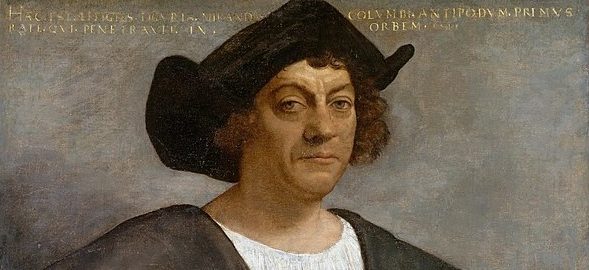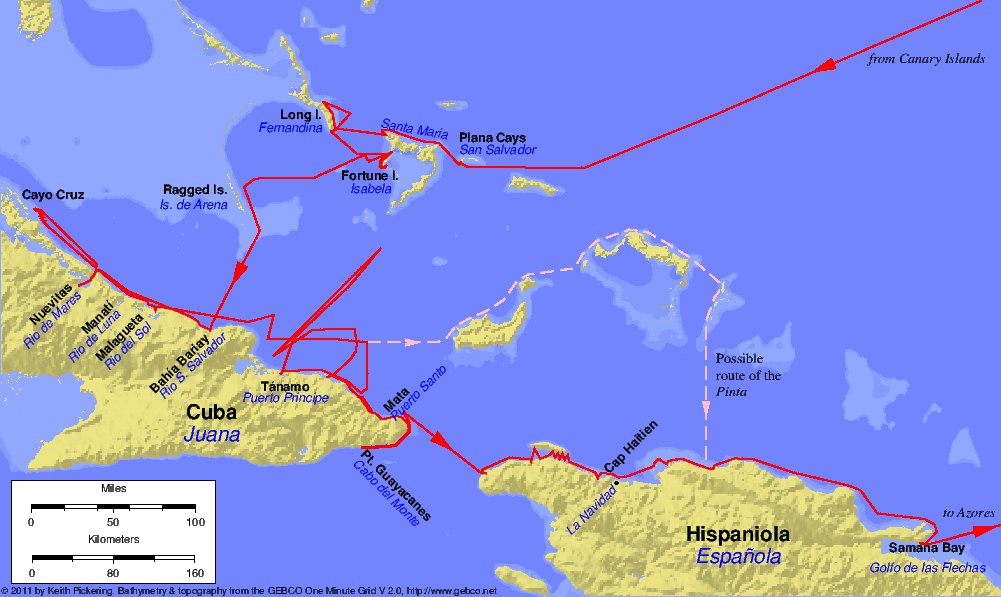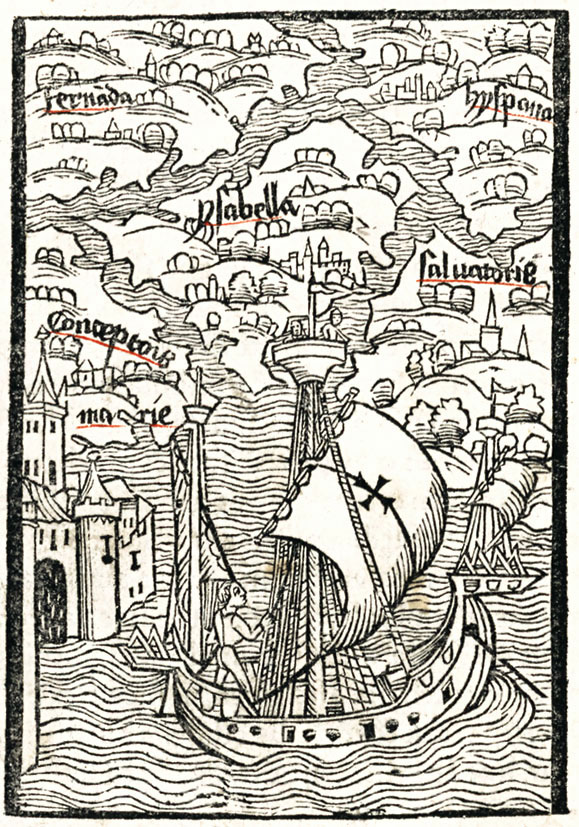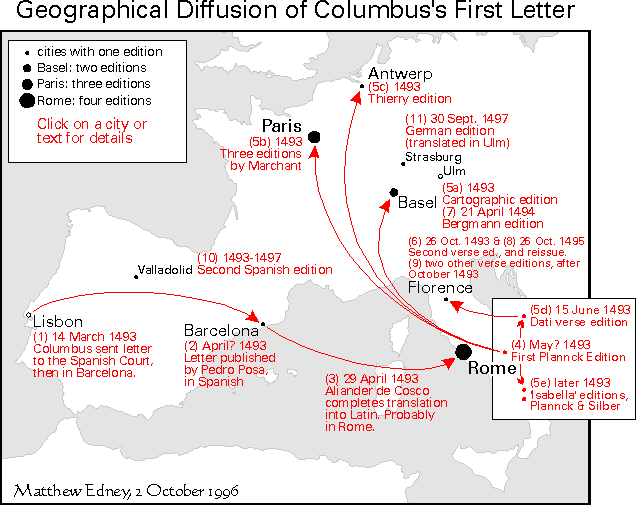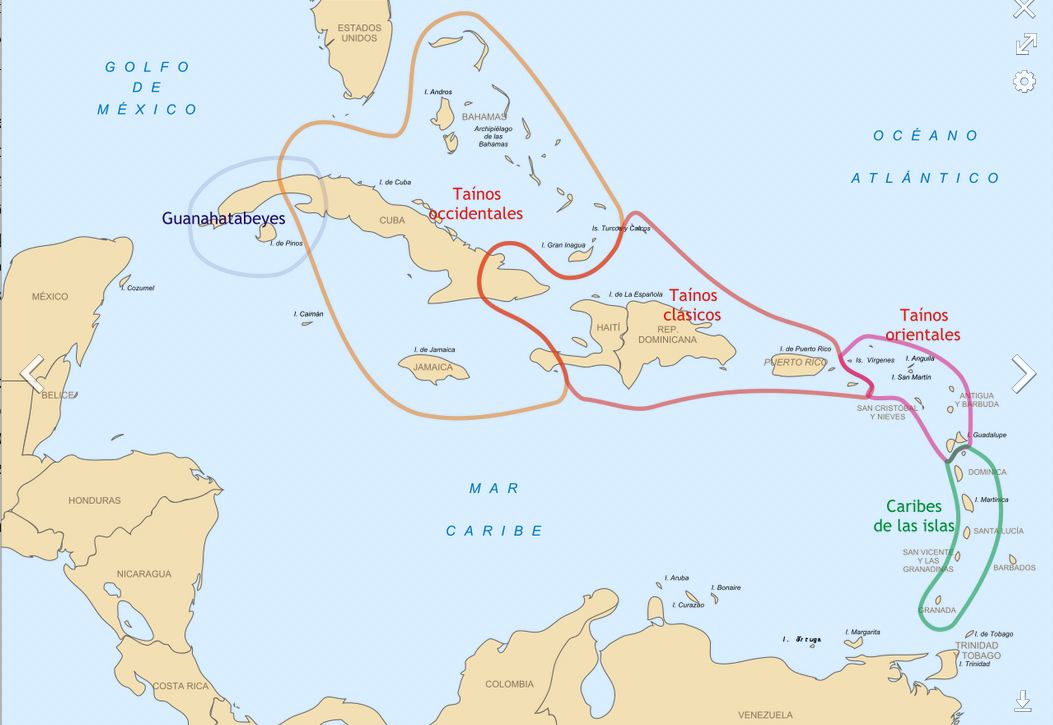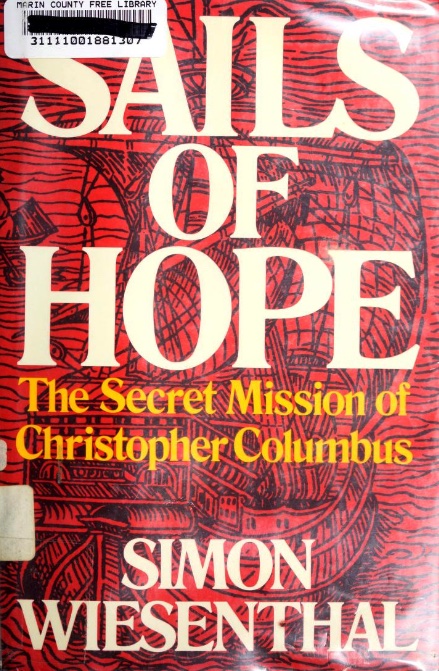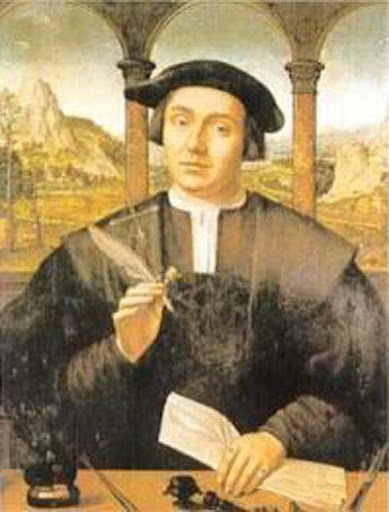Christopher Columbus was born in the bustling north-Italian port city of Genoa in 1451 CE, just a couple of years before the Ottoman Turks captured the great East Mediterranean metropolis of Constantinople (Istanbul) from its longtime Christian emperor. That Ottoman advance sent many of the merchants, financiers, and seaman who had built up Genoa and other north-Italian cities fleeing west, especially to Portugal, which was experiencing a long economic boom built on profits from the empire-building ventures its monarchs were pursuing around the coast of West Africa.
As an adult, Columbus (who was thought to be the subject of the 1517 painting above) became one of those economic migrants. He lived for a while in the Portuguese capital, Lisbon, and had a high-born Portuguese wife. He sailed with a number of Portuguese fleets around Europe’s Atlantic coast and on at least one of the fleets that Portugal’s royals sent on raiding/slaving missions down the coast of West Africa. Over the years, he became a man with a plan: it was to find a sea-route to connect Europe with the long-known riches of Asia by sailing west across the Atlantic.
Back in the late 15th century CE, most educated people in Europe understood that the earth was spherical. (It was mainly the Catholic church that was reluctant to admit that fact.) But Columbus’s plan had many very learned doubters. By the late 1480s, the navigators and map-makers in places like Portugal, Antwerp, or Seville had a rough idea of where the coast of East Asia lay on the globe relative to the west coast of Europe, and they judged it quite impossible that even the biggest and best of the European ships of that day could carry enough food and water for sailors to travel that far, as Columbus proposed to do, without replenishing their supplies.
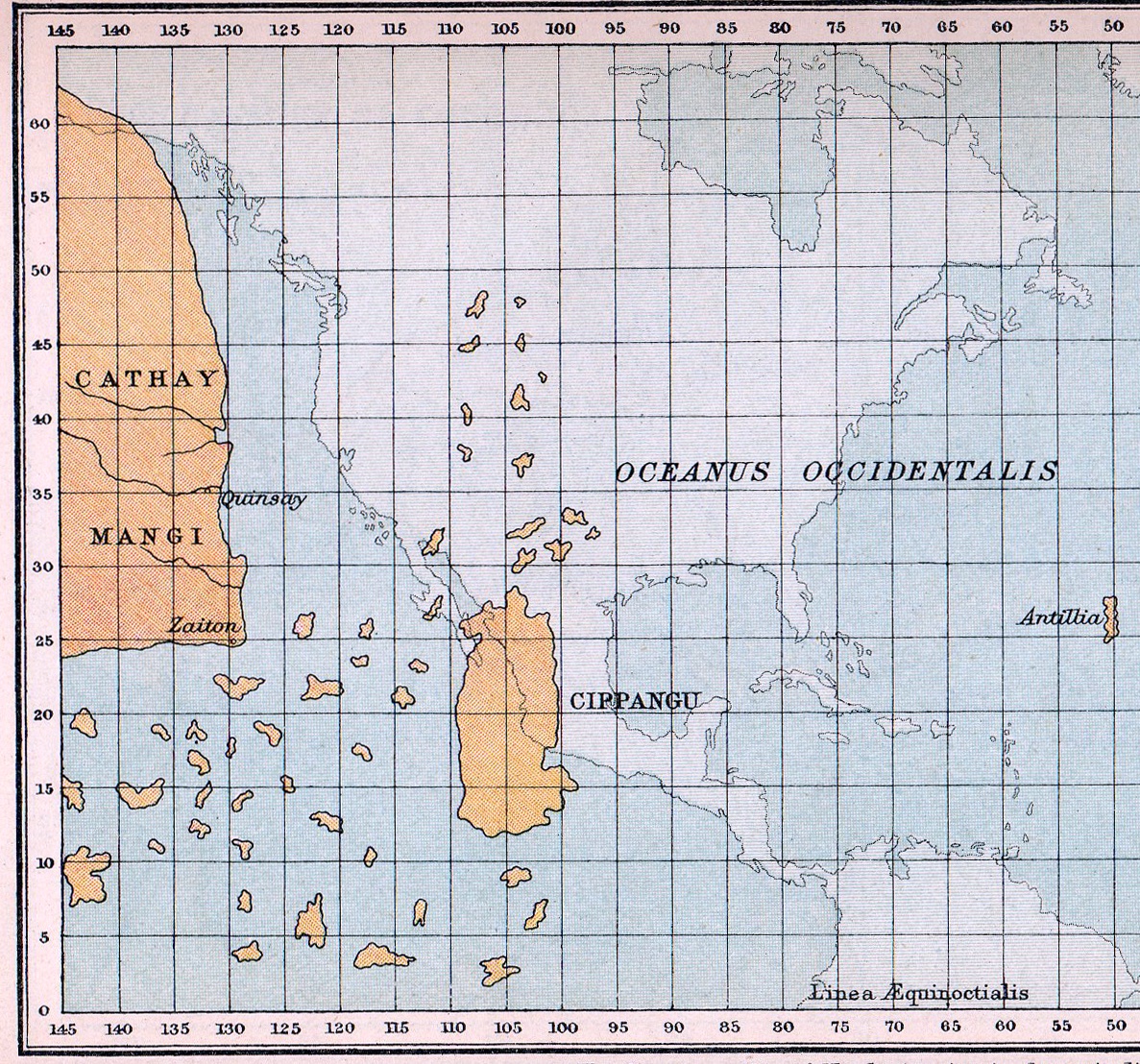
But Columbus was basing his sailing plan on maps such as this one, produced in 1474 by Paolo Toscanelli, which portrayed Japan (Cippangu) and China (Cathay) much further east than they actually are… that is, reachable from Europe by the ships of those days.
He took his plan to Portugal’s King John II and to John’s main competitors, Isabella and Ferdinand, the married monarchs of Castile and Aragon, the two polities that would later be called Spain. He pled with all of those monarchs to back it. But after consulting their specialists, they all turned him down.
Then in April 1492, he finally struck lucky. Just three months earlier, Ferdinand and Isabella had just celebrated the final victory in their very lengthy campaign to expel the last of the Muslim princes from the land they claimed in the Iberian Peninsula. They finally agreed to back Columbus’s plan, though they did not allocate much funding for it. Instead, most of the funding for the three small ships he was able to take was arranged privately by Ferdinand’s Finance Minister, Luis de Santángel.
The first voyage, 1492-93
In August 1492 Columbus set sail from the Castilian port of Palos de la Frontera, on what many educated Europeans were still convinced would be a fool’s errand. Two months later, he sighted the Bahamian island now known as Plana Cays, and some of its inhabitants.
In his expedition’s log for October 12, his secretary recorded that “the Admiral” (Columbus) traveled to the shore on a small, well-armed boat. He was carrying “the royal standard” of Spain and he “took possession… of that island for the King and Queen his sovereigns.”
He apparently did this on every new island on which he landed.
The secretary provided a direct quote from Columbus, explaining that as the people he met on the first island seemed friendly, he immediately began giving them some small trade-goods. Columbus went to say this about these Indigenes:
Weapons they have none, nor are acquainted with them, for I showed them swords which they grasped by the blades, and cut themselves through ignorance. They have no iron, their javelins being without it, and nothing more than sticks, though some have fish-bones or other things at the ends…
It appears to me, that the people are ingenious, and would be good servants and I am of opinion that they would very readily become Christians, as they appear to have no religion. They very quickly learn such words as are spoken to them. If it please our Lord, I intend at my return to carry home six of them to your Highnesses, that they may learn our language.
By the end of October 1492, he had reached Cuba and started sailing westward along its northern coast. He was still convinced—then, and until his death 14 years later—that the islands and lands he was encountering were perched on the eastern edge of Asia, so one of his goals in sailing west there was to reach the mainland of China (“the land of the Great Khan”), which Europeans of that era thought of (rightly) as much wealthier and more technologically advanced than their own societies.
But at some point, having still failed to encounter any representatives of a large central government, he turned back east. He put in at a few more places along the northern coasts of today’s Cuba, Haiti, and the Dominican Republic. At a place on the coast of Haiti that he called “La Navidad” his biggest ship, the Santa Maria, was shipwrecked. He used its timbers to construct a fort nearby and left 39 members of his party to man it. Then, he hastened to return to Iberia—taking his six captured Indigenes with him.
I imagine that he was eager to get back to Spain and inform his royal sponsors there—as well as the money-people and potential investors who, he knew, were eagerly awaiting the report of his voyage—as quickly as possible about what he had found. Also, to wave his success in the faces of his many doubters.
On his way back to Palos he made a quick stop in the Portuguese capital, Lisbon, arriving there in early March 1493. Historians say that may or may not have been an “accident” due to adverse winds. Anyway, it gave him the chance for a major brag, since two or three times over the preceding years Portugal’s King John II had turned down his appeal for Portuguese backing for his west-bound voyage.
The main key to Columbus’s brag to King John and everyone else in Europe was the captives he had brought with him from the Caribbean: they looked very different from the peoples the Portuguese had encountered along the west coast of Africa, and much more akin to the ideas Europeans had of Asian people.
Before his ship reached Lisbon, he started penning a report on his venture, and immediately upon reaching Lisbon he sent the report ahead to Santángel and the Spanish Monarchs. Its recipients, or perhaps only Santángel, speedily arranged for its contents to be set up in type, printed, and distributed. (You can read the full report on the KCL website here in Spanish, or here, translated into English.)
Of one place he stopped in Cuba, Columbus wrote: “I sent two men inland to find out if there was a king or any great cities. They travelled for three days and found an infinite number of small villages and countless people, but no sign of authority.” That must have been good news, as was the unfamiliarity of the Indigenes he encountered with any form of metal weapons.
About the island he named Española (Hispaniola)—either in present-day Haiti, or present-day DR—he wrote:
There are marvellous pine groves and broad meadows, and there is honey and there are many different kinds of birds and many varieties of fruit. In the interior there are many mines of metal and incalculable numbers of people. Española is a marvel; the sierras and the mountains and the plains and the fields and the land are so beautiful and rich for planting and sowing, for raising all kinds of cattle, for building towns and villages. The harbours are beyond the belief of anyone who has not seen them, and the many great rivers give good waters of which the majority bear gold. There are great differences between the trees and fruit and plants and those of Juana [Cuba]. On this island there are many spices and great mines of gold and other metals.
He summarized his findings thus:
Their Highnesses can see that I will give them as much gold as they require if Their Majesties will give me only a very little help; as much spice and cotton as Their Majesties may order to be shipped, as much mastic as they may order to be shipped… and as much aloe as they may order to be shipped and as many slaves as they may order to be shipped, and who will be from among the idolaters. I believe that I have found rhubarb and cinnamon and that I will find a thousand other things of value which the men I have left there will have discovered…
Columbus’s report took much of literate Europe by storm. In the publication map produced here, you can see that its text was printed in Spanish, in Barcelona in April 1493. The following month it was printed in Latin, in Rome. By the end of 1493 it had been published in six other Latin editions in Basel, Antwerp, and Paris. Plus, before the end of 1493 it had been translated into Italian verse and published thus in both Rome and Florence.
Clearly, throughout Europe, the literate classes were primed to receive news of a route to lands previously “undiscovered” by any European power, that could be a prime location for the easy and profitable extraction of enslaved laborers, precious metals, and valuable spices and crops.
The second voyage, 1493-96
Upon receiving the report, Ferdinand and Isabella speedily issued instructions authorizing a second voyage that would, historian David Stannard tells us (American Holocaust, p.67), put under Columbus’s command
the finest ships in Andalusia… commanded by the most expert pilots and navigators in the realm. Seventeen ships made the voyage and aboard those ships were more than 1200 soldiers, sailors, and colonists—including a cavalry troop of lancers and half a dozen priests.
This massive expedition set out from Cádiz in September 1493. David Stannard described this voyage as, “the true beginning of the invasion of the Americas.” It reached an island in the Lesser Antilles six weeks later, and Hispaniola before the end of November.
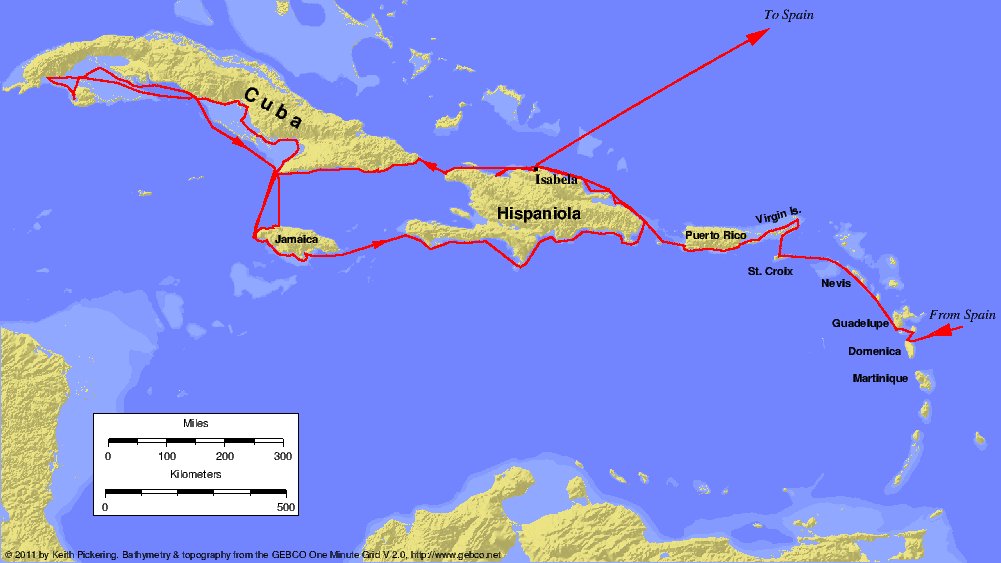
In Hispaniola, the adventurers made their way to the fort Columbus had built the year before at La Navidad. They discovered the fort burned down and all its occupants killed. Historian Antonio de la Cova quoted one of Columbus’s companions, Guillermo Coma, as having written that “bad feeling had arisen and had broken out in warfare because of the licentious conduct of our men towards the Indian women, for each Spaniard had five women to minister to his pleasure.”
On this second voyage, Columbus had been tasked by Queen Isabella with setting up trading posts in the East Asian cities whose riches had much earlier been extolled by Marco Polo. But of course, he never found them. Instead, he decided to establish a new settler city in Hispaniola, a little south of the site of La Navidad. It was called “La Isabela.”
David Stannard outlined (p.68) what happened next: “No sooner were the ships unloaded than sickness broke out among the crews. It quickly spread among the natives, who had come to greet the ships with gifts of fish and fruits… ” Stannard judged that this epidemic, which was the first of many to stalk the “New World” of the Americas in the aftermath of Columbus’s arrival, was some form of swine flu, carried by some of the pigs the expedition had picked up in the Canary Islands.
The epidemic spread among the Indigenes like wildfire. Stannard cited expedition member Gonzalo Fernández Oviedo as writing that, “So many Indians died that they could not be counted. All through the land the Indians lay dead everywhere. The stench was very great and pestiferous.”
The Spanish invaders were also affected by the sickness but not to such a great degree. Columbus sent out reconnaissance parties to Cuba, Jamaica, and other nearby islands.
Stannard again (p.69-71, passim):
Wherever the marauding, diseased,and heavily armed Spanish forces went out on patrol, accompanied by ferocious armored dogs that had been trained to kill and disembowel, they preyed on the local communities—already plague-enfeebled—forcing them to supply food and women and slaves, and whatever else the soldiers might desire… Once on Hispaniola, however, Columbus fell ill… and whatever little restraint he had maintained over his men disappeared as he went through a lengthy period of recuperation. The troops went wild, stealing, raping, and torturing natives, trying to force them to divulge the whereabouts of the imagined treasure-houses of gold….
The massacres continued. Columbus remained ill for months while his soldiers wandered freely. More than 50,000 natives were reported dead from these encounters by the time the Admiral [Columbus] had recovered from his sickness. And when at last his health and strength had been restored, Columbus’s response to his men’s unorganized depradations was to organize them. In March of 1495 he massed together several hundred armed troops, cavalry, and a score or more of trained attack dogs. They set forth across the countryside, tearing into assembled masses of sick and unarmed native people, slaughtering them by the thousands. The pattern set by these raids would be the model the Spanish would follow for the next decade and beyond….
With the same determination Columbus had shown in organizing his troops’ previously disorganized and indiscriminate killings, the Admiral then set about the task of systematizing their haphazard enslavement of the natives. Gold was all they were seeking, so every Indian who was not a child was ordered to deliver to the Spanish a certain amount of the precious ore every three months. When the gold was delivered the individual was presented with a token to wear around his or her neck… Anyone found without the appropriate number of token had his hands cut off… And the soldiers never ceased to take delight in killing just for fun.
For his part, De la Cova noted this aspect of the Columbus’s treatment of Hispaniola’s Taino Indigenes:
He introduced Indian slavery suggesting that it would be lucrative enough to compensate for the meager supply of gold found. In 1495, he and his men went on a raid in the interior of Española capturing as many as fifteen hundred Taino, men, women and children. Columbus picked the 500 best specimens and sent them to Spain. Two hundred of these five hundreds Taino died enroute to Spain. Columbus’s reaction was to exclaim: “Let us in the name of the Holy Trinity go on sending all the slaves that can be sold.”
That second voyage that Columbus made to the Caribbean lasted 33 months. He arrived back in Spain in June 1496. David Stannard estimated (p.74) that by that time the activities of his expedition had reduced the Indigenous population of Hispaniola from eight million to between four and five million.
Before he left Hispaniola in 1496, Columbus tried to organize the continuing exploitation of the Indigenes by parceling out various groups of them to individual Spanish conquistadors/settlers who would remain on the island. Each Spanish settler would be free to exploit the labor of “his” enslaved natives however he chose, under an extension of the encomienda (slavery) system the Spanish Catholics had long used back home to organize the exploitation of residents of lands newly taken from the Muslims.
The third voyage, 1498-1500
He launched his next voyage to the Caribbean in 1498. By then, many of the Spanish settlers he had implanted in Hispaniola on the second voyage had become angry that the gold and other riches he had promised them never materialized. They mounted an armed uprising against him.
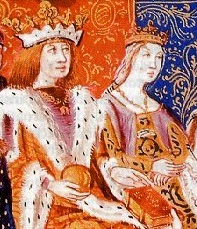
Equally importantly, Ferdinand and Isabella had become frustrated by his failure to connect with the long-promised riches of Asia. So the Monarchs revoked the authorization they had previously given that he and his heirs could rule over all the lands he found for all time. And while he was in Hispaniola on this third voyage, they also sent over the well-connected clerical judge Francisco de Bobadilla to investigate him and his brothers on charges that they had accepted bribes, enslaved the natives, under-paid the promised “royal one-fifth” due to the Monarchs for all the pearls and gold they found, mishandled a key rebellion by the Spanish settlers in Hispaniola… Oh, and also that he had committed treason.
(Intriguingly, Babodilla took with him to Hispaniola “14 Amerindians who had previously been Columbus’ slaves [in Spain], and who were now being returned to their home.” It looked as if the Monarchs were trying to take some kind of a stand against the enslavement of the Caribbean Indigenes—or at least, against the importation of such enslaved persons into Spain?)
Once arrived in Hispaniola, Bobadilla ordered Columbus to be taken back to Spain in chains. When he appeared before the Monarchs in Granada’s Alhambra Palace in 1500, he begged their forgiveness and was released, though the Monarchs confirmed their revocation of his governorship. (Bobadilla meanwhile had drowned in a shipwreck off Hispaniola.)
The fourth voyage, 1502-04
Two years later, the Monarchs dispatched a presumably somewhat chastened Columbus on a fourth voyage to the Caribbean in the hope that he might yet discover the route to Asia. That time, he “discovered” Honduras and much of the east coast of Central America down to Panama, instead. But he still did not reach Asia.
On that same voyage, he got into yet another fight with some of the armed settlers still rampaging in Hispaniola under a new governor. He and his son Fernando barely escaped alive. In September 1504, they had to buy their own tickets to leave Hispaniola when they returned to Spain. He and his family continued trying to sue the Monarchs in the courts for the Caribbean riches they believed were theirs.
In 1506, he died, aged 54.
Columbus’s legacy
In the Caribbean islands he visited and conquered, Columbus was well able to apply the lessons he had learned from his years living in Portugal and traveling as a merchant with portions of Portugal’s empire-building fleet. The most important of those lessons was that when well-armed European naval raiding parties found distant pieces of land they could easily conquer, then extracting riches of all kinds and capturing, enslaving, and exploiting the Indigenous people could be a very profitable venture that—if packaged correctly as fulfilling some kind of “Christian” mandate—could bring great glory, as well as great wealth, to all the European participants.
The Christian mandate aspect of this was not long in coming. The same month that Columbus set out on his first voyage, August 1492, a new pope was inaugurated in Rome, Alexander VI, who was from the Spanish Borgia family. After Columbus returned to Spain in March 1493, with the triumphant news of his “discovery” of a new route to Asia, Alexander issued in short order four “Papal Bulls” (decrees) that recognized Spain’s claim to any lands newly “discovered” that were not already held by a Christian prince. The need for four separate Bulls, each of which over-rode the previous ones, arose because of the stern insistence of Portugal’s King John II that his country’s empire-building interests still be respected.
The fourth of Alexander’s Bulls, Dudum siquidem, was issued just one day after Columbus set out on his second voyage, in September 1493. It granted Ferdinand and Isabella control and sovereignty over: “all islands and mainlands whatsoever, found and to be found, discovered and to be discovered, that are or may be or may seem to be in the route of navigation or travel towards the west or south, whether they be in western parts, or in the regions of the south and east and of India.”
King John was upset with this text—especially with its mention of India, which he was definitely targeting for the next phase of his country’s empire-building project. So he decided to negotiate directly with the Spanish Monarchs and won the world-dividing Treaty of Tordesillas with them the following year.
Dudum siquidem assigned to the Spanish Monarchs all the same rights over the peoples and resources of newly conquered (non-Christian) territories that the 1452 Bull Dum Diversas had allotted to Portugal in the non-European lands it had conquered. That included the right to enslave the Natives. Some scholars have argued that the right to enslave the Natives was somehow intended to facilitate their conversion to Christianity, though it is very hard to see how that might happen, given that it was usually expressly forbidden for Christians to enslave other Christians.
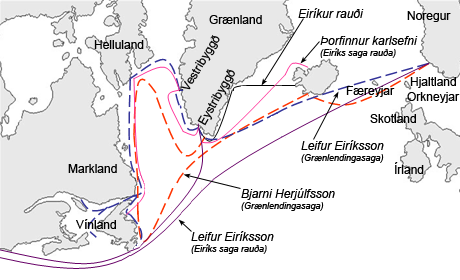
Columbus was not the first European expedition head to encounter and maintain a lengthy presence in the Americas. That honor belonged to the Vikings, who in around 1000 CE had landed at, and established short-lived settlements in, some parts of today’s Newfoundland.
Columbus and his expeditions reached a different, probably more easily accessible, part of the Americas than that reached by the Vikings, and they did so with the backing of the large, well-honed military-financial complex that had just helped Ferdinand and Isabella to finally win the Reconquista of their portion of Iberia. That military-financial complex was thus now suddenly available to push Columbus’s empire-building forward with great energy. (That was similar to what happened in 1990-91, when suddenly the Americans’ decades-long “Cold War” with the Soviet Union collapsed and the U.S. military had a massive, well-primed military machine standing at the ready in Europe that could easily all be diverted down to confront Saddam Hussein in the Persian Gulf… )
As noted above, the settler colonialists whom Columbus brought to the Caribbean from 1493 on were a brutal, avaricious bunch of thugs with far greater lethal capabilities than the Vikings were ever able to muster. David Stannard wrote (pp.74-75) that:
By 1496… the [Native] population of Hispaniola had fallen from eight million to between four and five million. By 1508 it was down to less than a hundred thousand. By 1518 it numbered less than twenty thousand. And by 1535, say the leading scholars on this grim topic, ‘for all practical purposes, the native population was extinct.’
Over the years that followed Columbus’s voyages, the Spanish conquistadors continued to rampage all over Hispaniola and on many other Caribbean islands. Between the hardships of the encomienda/slavery system to which they subjected the Indigenes—originally in an always-hard search for gold and later in the slave-worked plantations that some of them established—and the effects of the pestilences and plagues they brought with them, these conquistadors/settlers radically reduced, or often exterminated, the Indigenous populations of all those islands. They also—still following in Columbus’s footsteps—started to extend their raiding and plundering to the eastern (Caribbean) coast of Central America and then, by crossing the isthmus at Panama, to the Pacific coast of Central and South America.
By 1519 they had established cities in Veracruz (Mexico) and Panama, and by 1521 they had captured Tenochtitlan, the capital of the powerful Aztec empire. Everywhere they went, they followed the powerful template established by Columbus on his breakthrough Second Voyage. (I’ll be writing more about those other “achievements” of the early Spanish Empire, in the next phase of this project.)
Postscript: Columbus and the quest for a ‘Jewish safe haven’
Among the sources that I consulted for this essay was a book called Sails of Hope: The Secret Mission of Christopher Columbus, that was originally published in German in 1972 by none other than the Holocaust survivor, celebrated Nazi-hunter, and ardent Zionist, Simon Wiesenthal. Macmillan published an English translation the following year. His book is an apparently well-sourced account of the many Jewish dimensions of Columbus’s settler-colonial project, that is also openly laudatory of the entire project. (You can read the full text of the English-language version of the book, here.)
As I noted above, Columbus’s principal initial backer at the court of the Spanish Monarchs was Ferdinand’s Finance Minister Luis de Santángel. Santángel was a converso (converted-to-Catholicism)Jew who had seen some of his own relatives burned to death by the Catholic-supremacist Inquisition that the Monarchs were pursuing in that same exact time period.
In Sails of Hope, Wiesenthal devoted several pages to trying to establish that Columbus himself may also have been a converso. He admitted that he never fully made that case. But his book did present a very persuasive argument that one of the main goals of Santángel, Columbus, and others involved in Columbus’s project was to find a safe haven for Jewish survivors of the Inquisition.
The Muslim rulers who governed Spain prior to the arrival of the Catholic Reconquista had provided a generally welcoming, supportive environment in which Jews (and Eastern-rite Christians) had been able to thrive and reach the greatest heights of intellectual and artistic endeavor. But as the Catholic powers of Portugal and Spain—especially Spain—seized control of increasing parts of the Iberian Peninsula during the centuries leading up to 1492, they undertook harsh crackdowns on the remaining remnants of the newly conquered areas’ once-thriving Muslim and Jewish communities.
In 1478, the two Spanish Monarchs established the Inquisition as a special, investigative organization designed to “guard the religious orthodoxy” of their realm. And in 1492 itself, the year the Spanish Monarchs completed the Reconquista of the areas they claimed, they issued a decree that summarily ordered all Muslims and Jews still living in Isabella’s Kingdom of Castile to convert to Catholicism or to leave the kingdom immediately.
One of the continuing concerns of the Monarchs and their Inquisitors was that some of the people or families who claimed to have “converted” from either Judaism or Islam to Catholicism had not done so in good faith, but were still secretly harboring adherence to their previous religion or covertly practicing some of its rituals. That was where the inquisitors came in: their job was to ferret out any suspicion of such deception and to punish the conversos who engaged in it. English-Wikipedia cites an estimate that during the 300-year history of its operation, the Inquisition prosecuted around 150,000 people, “of which between 3,000 and 5,000 were executed.” And the terrorizing effects of the Inquisition were felt far beyond the numbers of those directly targeted by it.
We can see some interesting parallels between the actions of Luis de Santángel and the other conversos who backed Columbus’s project in the late 15th century and those of the more recent Zionists who reacted to the horrors of the Nazis’ anti-Jewish Holocaust by arguing that Jewish people should support a settler-colonial project in the non-European world in which they and their “Western” allies could create a safe haven for Jewish survivors of the recent terror. In both cases, the original anti-Jewish terror had been perpetrated by European Christians—but then, the proponents of both these “Jewish safe-haven” projects built them completely at the expense of the Indigenous inhabitants of the targeted area.
Simon Wiesenthal’s thesis of Columbus’s project as a “Jewish safe haven” project was taken up with gusto by a more recent Jewish-American writer, Edward Kritzker. He devoted the entire first chapter of his 2008 book Jewish Pirates of the Caribbean to a seemingly well-sourced celebration of the sizeable role that conversos had played in both Columbus’s original project in Hispaniola and a follow-on attempt that his son Diego and a converso called Juan d’Esquivel led in 1511-13, to establish slave-powered settler colonialism just south of there, in Jamaica.
Kritzker noted that many of the participants in those ventures were either conversos or “Portugals”–a term frequently used in those days to denote Jews, since many members of Spain’s former Jewish population had been temporarily able to find a more secure life in Portugal than in Spain.
Kritzker included in his book (pp.26-27) this glowing account of the early years of the settlement that Diego Columbus and Juan d’Esquivel established in Jamaica:
Despite the paucity of gold, island life was pleasantly rewarding. Jamaica was a fertile land, and the average allotment [under the encomienda/slavery system] of 150-200 pacified Indians per settler meant that one could have a successful ranching operation, made all the more comfortable by a harem of baptized Indian women….
[F]or more than a century [Columbus’s] heirs kept Jamaica off-limits to the hooded Inquisitors who were empowered to root out heresy in all Spanish territories. As far as Jamaica’s proprietors were concerned, as long as their “Portugals” wore a Christian mask, no one might question the sincerity of their religious beliefs.
One last note about the parallels between the settler-colonial projects that Columbus and his heirs launched in the Caribbean and the more recent settler-colonial projects the Zionists built in Palestine. Yes, one can understand the desire that any group of people who have recently survived a terrible genocide might feel, to find a safe haven for themselves. But in both those cases, joining a settler-colonial project was far from the only option. In the decades after the European Holocaust of 1938-45, its Jewish survivors had several options open to them other than joining the settler-colonial project in Palestine. And in the decades before and after 1492, large numbers of the Jewish residents of Iberia who wanted to hang onto their faith found a safe place in which to do so, in the Ottoman Empire and other Muslim polities.
In both those cases, joining a settler-colonial project that was built centrally on the dispossession or extermination of other peoples was not the only option the genocide survivors had. But both Wiesenthal and Kritzker openly supported and lauded the settler-colonial option.
